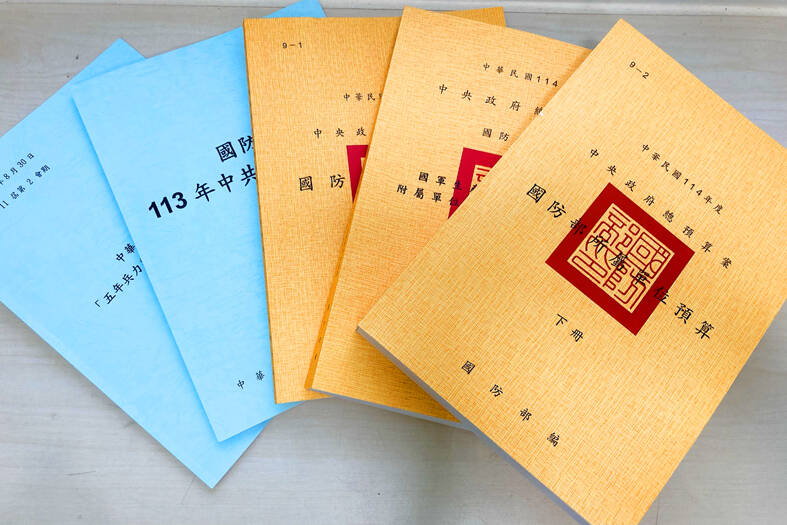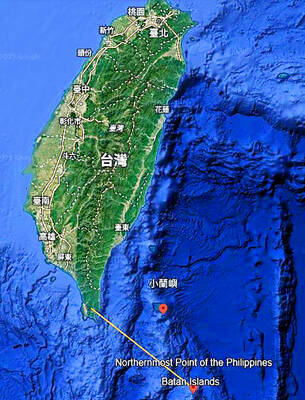The Ministry of National Defense yesterday submitted to the Legislative Yuan its five-year defense plan, which includes spending an additional NT$6.9 billion (US$216 million) next year on reserve units, asymmetric warfare systems, command and control resiliency, and field medicine.
The report, titled “The Five-Year Force Design and Policy Plan,” outlines the ministry’s vision for the armed forces and budget priorities for the coming years.
A publicly available version of the document lists an expected spending of NT$145.8 billion for next fiscal year, an increase of 16 percent from this year.

Photo: Aaron Tu, Taipei Times
Next year’s military programs include funds for the Hai Kun-class indigenous defense submarines, ongoing construction of six minesweepers, attack drones and T112 rifles, the ministry said.
The next-generation Aegis Combat System-equipped frigate and Grumman E-2 Advance Warning and Air Control Systems programs were absent from the public version of the report.
The ministry said that heightened tensions with China necessitated a budget increase to replenish spare parts and ammunition stockpiles, promote indoctrination and combat training, repair ranges, and build barracks and accommodations for conscripts.
The emphasis on these items and projects is part of an effort to boost fighting capabilities to defend the nation, it said.
The ministry is to allocate NT$284 billion to produce Hai Kun-class submarines over the next 14 years, it said.
Next year’s portion of this budget is NT$2 billion and NT$17 billion the year after that, it said, adding that the annual submarine budget would exceed NT$20 billion from 2027 to 2035 and peak at NT$32.1 billion in 2031.
The Hai Kun-class submarines would be built in three phases of three, two and two boats respectively, a source said on the condition of anonymity.
The nation expects to field two Hai Kun-class submarines in three years, the source said, citing National Security Council member Huang Shu-kuang’s (黃曙光) remarks at a government meeting.
The five-year plan shows that the armed forces would continue to be guided by the “resolute defense and multidomain deterrence” doctrine, online news outlet Storm Media said.
The asymmetric force design aims to create a “resilient, lethal and decentralized” military that features “multiple redundancies, cost-effectiveness, mobility and capacity for deception,” the outlet quoted the ministry as saying in the report.
The plan’s goalposts would include “distributed command and control, automation, artificial intelligence and other key indicators of a modern force,” the ministry said.
The nation will continue to source equipment mainly through domestic production and US arms sales, it added.
Tien Chien II air-defense missiles, emergent future warfare systems, Hai Kun-class submarine construction, Hai Chien-class submarine upgrades, Chien Hsiang anti-radiation loitering munition and Hsiung Sheng long-range land-attack missiles would be the main indigenously sourced programs, it said.
Meanwhile, US arms sales are expected to provide air-launched precision-guided missiles, very-high-altitude drones, Patriot PAC-3 air defense missiles, the coastal defense variant of Harpoon anti-ship missiles, heavy torpedoes and next-generation tactical area communication systems, the ministry said.
Taiwan would improve its collaborative relationship with the Pentagon to focus on control over weapons system deliveries and supply-chain risk mitigation, and increase the capacity to train Taiwanese armed forces to use and deploy US-made platforms, it said.
The ministry also said that it would make rolling adjustments to the organization, equipment and numerical strength of regular and reserve forces in anticipation of defensive requirements.
According to the force design, volunteer troops would compose the principal combat units, while conscripts and reservists would form the defensive and mobilization units respectively, it said.
Integrating defensive units into the command structure, improving the quality of junior and noncommissioned officers in reserve units, and shoring up civil defense are to be the military’s organizational priorities, the ministry said.

SECURITY: As China is ‘reshaping’ Hong Kong’s population, Taiwan must raise the eligibility threshold for applications from Hong Kongers, Chiu Chui-cheng said When Hong Kong and Macau citizens apply for residency in Taiwan, it would be under a new category that includes a “national security observation period,” Mainland Affairs Council (MAC) Minister Chiu Chui-cheng (邱垂正) said yesterday. President William Lai (賴清德) on March 13 announced 17 strategies to counter China’s aggression toward Taiwan, including incorporating national security considerations into the review process for residency applications from Hong Kong and Macau citizens. The situation in Hong Kong is constantly changing, Chiu said to media yesterday on the sidelines of the Taipei Technology Run hosted by the Taipei Neihu Technology Park Development Association. With

CARROT AND STICK: While unrelenting in its military threats, China attracted nearly 40,000 Taiwanese to over 400 business events last year Nearly 40,000 Taiwanese last year joined industry events in China, such as conferences and trade fairs, supported by the Chinese government, a study showed yesterday, as Beijing ramps up a charm offensive toward Taipei alongside military pressure. China has long taken a carrot-and-stick approach to Taiwan, threatening it with the prospect of military action while reaching out to those it believes are amenable to Beijing’s point of view. Taiwanese security officials are wary of what they see as Beijing’s influence campaigns to sway public opinion after Taipei and Beijing gradually resumed travel links halted by the COVID-19 pandemic, but the scale of

A US Marine Corps regiment equipped with Naval Strike Missiles (NSM) is set to participate in the upcoming Balikatan 25 exercise in the Luzon Strait, marking the system’s first-ever deployment in the Philippines. US and Philippine officials have separately confirmed that the Navy Marine Expeditionary Ship Interdiction System (NMESIS) — the mobile launch platform for the Naval Strike Missile — would take part in the joint exercise. The missiles are being deployed to “a strategic first island chain chokepoint” in the waters between Taiwan proper and the Philippines, US-based Naval News reported. “The Luzon Strait and Bashi Channel represent a critical access

Pope Francis is be laid to rest on Saturday after lying in state for three days in St Peter’s Basilica, where the faithful are expected to flock to pay their respects to history’s first Latin American pontiff. The cardinals met yesterday in the Vatican’s synod hall to chart the next steps before a conclave begins to choose Francis’ successor, as condolences poured in from around the world. According to current norms, the conclave must begin between May 5 and 10. The cardinals set the funeral for Saturday at 10am in St Peter’s Square, to be celebrated by the dean of the College